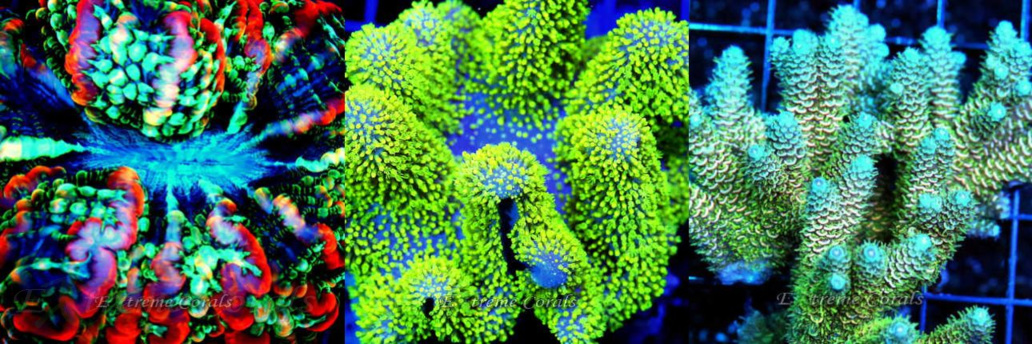Extreme Corals News and Updates
Evolution of Reef Keeping
With technology advancing and a better understanding of coral biology reef keeping as a whole has changed. Here we will talk about popular specimens, lights, and more.
Are you up to date with all evolutions of reef keeping has seen over the years? Read along to see what changes have come over the years!
by scott Shiles • March 09, 2023
SPS Coral Care, Soft Corals Care, Reef Tank Maintenance, Reef Tank Equipment, LPS Coral Care, All Corals, Zoanthids Coral Care
Exploring the evolution of reef tanks over the years and the corals that are commonly kept in them. Reef tanks have become a popular addition to many homes and businesses, with people seeking to replicate the beauty and diversity of coral reefs in their own living spaces. Over the decades, reef tanks have evolved considerably, with new technologies and a better understanding of coral biology allowing for more successful and sustainable aquariums.
The 1970s and 1980s marked the beginning of the modern reef tank hobby. At the time, saltwater aquariums were primarily used for keeping fish, but hobbyists began to experiment with keeping live corals and other invertebrates in their tanks. The tanks of this era were relatively simple, with low-tech filtration and lighting systems. Corals were often collected from the wild, and the focus was more on the aesthetics of the tank than the welfare of the organisms inside.
In the 1990s, reef tanks began to experience a surge in popularity, thanks in part to advances in technology that made it easier to maintain a healthy and thriving ecosystem. Protein skimmers, which remove organic waste from the water column, became more common, as did high-powered metal halide lighting systems that allowed for better coral growth. Hobbyists also began to recognize the importance of maintaining stable water chemistry and the role of beneficial bacteria in breaking down waste products.
The early 2000s saw the rise of LED lighting technology, which provided an energy-efficient and customizable way to light reef tanks. This allowed for a wider range of coral species to be kept in home aquariums, including more light-sensitive species. Additionally, the use of live rock, which is porous rock taken from the ocean that provides a habitat for beneficial bacteria and other organisms, became more popular, as it helped to establish a more stable and diverse ecosystem in the tank.
In recent years, the focus in the reef tank hobby has shifted towards sustainability and conservation. There is now a greater emphasis on captive breeding of corals and other marine organisms, which reduces the impact on wild populations. In addition, advances in water testing and monitoring equipment have made it easier for hobbyists to maintain optimal water chemistry and identify potential issues before they become a problem.
So, what types of corals are commonly kept in reef tanks? There are a wide variety of coral species that can be kept in home aquariums, with varying levels of difficulty in care. Some of the most popular coral species include:
- Soft corals: These are the easiest corals to care for and come in a range of shapes and colors. They do not have a hard skeleton and are generally less demanding in terms of lighting and water flow. Popular specimens include Leather Corals, Mushroom Corals, Ricordia Mushroom, Discosoma Mushrooms, Clove Polyps
- LPS (Large Polyp Stony) corals: These corals have a hard skeleton and larger polyps than SPS corals. They require moderate to high lighting and water flow and are generally considered to be intermediate in terms of difficulty. Popular specimens include Hammer Coral, Torch Coral, Acanthophyllia, Scolymia, Acanthastrea, Bubble Coral, Cynarina, Goniopora, Indophyllia, Wellsophyllia, Frogspawn, Trachyphyllia, Candy Cane, Echinophyllia and Blastomussa
- SPS (Small Polyp Stony) corals: These corals have a hard skeleton and small polyps. They require high lighting and water flow and are considered to be the most difficult to care for. Popular specimens include Acropora, Montipora, Hydnophora, Pocillopora, Stylophyora, and Porites
- Zoanthids: These are a type of soft coral that come in a wide range of colors and patterns. They are relatively easy to care for and can be a good choice for beginners.
In conclusion, reef tanks have come a long way over the decades, with advances in technology and a greater understanding of coral biology allowing for more successful and sustainable aquariums. Today's reef tanks are a testament to the beauty and diversity of coral reefs, and the hobby is likely to continue to evolve and grow in the years to come.

